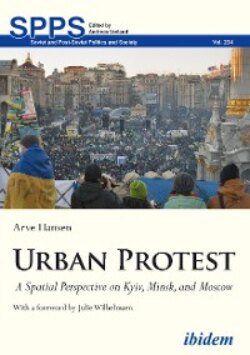Оглавление
Arve Hansen. Urban Protest
Abbreviations
A Note on Language
Foreword
Preface
1 Starting Point
Structure
2 Space in Context
2.1 Complexities of Urban Contention
2.1.1 Form
2.1.2 Motivation
2.1.3 Waves
1917
1950s and 1960s
1985 to 1991
2000s
2.2 Ukraine, Belarus, and Russia
Similarities
Differences
Outside factors
2.3 Relevance
3 Mapping the Field
3.1 Protests
3.1.1 Repertoires
Containment and Kettling
3.1.2 Nonviolent Contention
3.1.3 Colour Revolutions
Popular Revolutions or (Geo-)Political Technologies? 9
3.1.4 Non-spatial Factors
3.2 Space
3.2.1 Public Space
“Public Space” and “the Right to the City”
3.2.2 Physical Space
Urban Planning, Architecture, and Urban Geography
Prospect-Refuge Theory
3.2.3 Contested Spaces
3.3 The Gap
4 Definitions and Research Questions
4.1 What Is a Mass Protest?
Mass Protests and Social Movements
4.2 What Is Urban Public Space?
Urban Space and Public Space
Urban Public Space
4.3 Research Questions
5 Theorising and Development
5.1 Approaches to Theorising
Applying Swedberg’s Theory
5.1.1 Field Work
5.1.2 Respondents
The Main Interview Structure
5.1.3 Mapping
5.2 Ethical Considerations
5.2.1 Interview Ethics
Pre-interview
Interview
Post-interview
Russia
5.2.2 Practical Utility
5.3 Geographical Determinism
5.4 Conception
5.4.1 M.A. Thesis
5.4.2 PhD Proposal
5.5 Theorising
5.5.1 Prestudy
5.5.2 Formulating a Theory
5.5.3 Transitional Study
Chișinău
Minsk
5.6 Causal Chains
5.7 Main Study
5.8 Post-test Theorising
6 Variables and Methodology
6.1 Independent Variables
6.1.1 Perceived Elements
6.1.2 Physical Elements
6.1.3 Social Elements
6.2 Intermediary Variables
6.2.1 Spatial Qualities
6.2.2 The Political Environment
6.3 Dependent Variables
6.3.1 Emergence
6.3.2 Realisation
6.3.3 Impact
7 Prestudy
Methods and Theory
7.1 Physical Space
7.1.1 Spatial and Urban History
7.1.2 Daily Use
7.1.3 Protest Space
7.2 Symbolic Value
7.2.1 25 Years of Protest
7.3 Function
7.4 Conclusions
8 Transitional Study
The Success and Failure of Mass Protests
8.1 A Spatial Perspective
Research Question, Approach, Methodology
8.2 Belarusian Protests from Glasnost’ to Lukashenka
8.3 Perceived elements
8.3.1 October Square
8.3.2 Independence Square
8.4 Social Elements
8.4.1 The Political Centre
8.4.2 The People’s Centre
8.4.3 Independence Square
8.4.4 October Square
8.5 Physical Elements
8.5.1 October Square and Ploshcha 2006
8.5.2 Independence Square and Ploshcha 2010
8.6 Conclusions
9 Main Study
9.1 Towards a Spatial Perspective
9.1.1 Spatial Elements
9.1.2 Spatial Qualities and the Political Environment
9.1.3 Protest Areas
9.2 Moscow, Swamp Square and theMarch of Millions
9.2.1 The Political Environment of Moscow
9.2.2 Public Spaces in Moscow
9.2.3 The Elements. Perceived Elements
Physical Elements
Social Elements
9.2.4 Spatial Qualities
9.2.5 Emergence, Realization, Impact
9.3 Conclusions
10 To Paris and Beyond
10.1 Republic Square and the Yellow Vests
10.1.1 Applying the Model
10.2 Summary and Conclusions
10.2.1 “So what?”
10.2.2 Limitations
10.3 Moving On
References
